November 28, 1940
Jimmy Starr
Errol Flynn has offered his boat, the Sirocco, to the United States Navy and promises to maintain the running expenses (about $50 per day.) A nice gesture which Uncle Sam probably will accept.
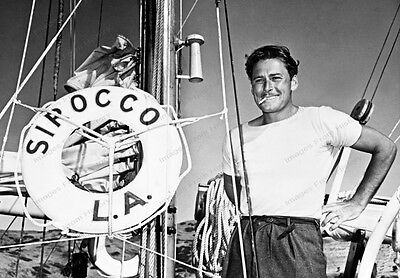
— Tim
November 28, 1940
Jimmy Starr
Errol Flynn has offered his boat, the Sirocco, to the United States Navy and promises to maintain the running expenses (about $50 per day.) A nice gesture which Uncle Sam probably will accept.

— Tim
Thanksgiving, 1938
Errol Flynn’s Thanksgiving present from Lili Damita was a long distance call from Paris. It was collect and cost him $73.*
Here’s Lili hosting a cocktail party at the Hotel Plaza Athénée in Paris, November 1938. Her guests include Ann Warner, Marlene Dietrich, Anderson Lawler, and Vera Matzouki.
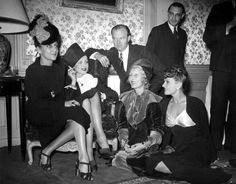
* $73 in 1938 = $1348.11 in 2020
— Tim
November 26, 1942
New York Times

…
The robust glamour of the early days of prize-fighting, when the burly, muscle-bound practitioners of bareknuckle mayhem slugged, kicked, bit and clawed one another into submission under the guise of sport, has been recreated in most of its gory glory in “Gentleman Jim,” which opened last evening at the Strand. Though it is primarily a fight-fan’s delight, this lusty Warner Brothers film biography of the life and times of James J. Corbett, who danced his way to fistic immortality and introduced a note of refinement into the fight game, has Errol Flynn in the title role and enough other good qualities as an entertainment to make it a satisfying show for anybody’s money.
For here is not only the story of a great and colorful ring personality but a vividly illustrated album of a once outlawed sport at which the spectator was wont to keep one eye on the gladiators, the other peeled for the raiding police. With Raoul Walsh pulling the directorial reins, the action is sharply pointed most of the way, particularly in the fight sequences. Naturally the highpoint of the drama is Corbett’s historic meeting with the mighty John L. Sullivan at New Orleans on Sept. 7, 1892. If the original battle was as good as that served up by the Warners, then it surely must have been a corker. And it is on this triumphant note of Corbett’s remarkable ring career as a scientific boxer and the first heavyweight champion under the present Marquis of Queensberry rules that the film ends.
In recounting Corbett’s professional career, “Gentleman Jim” sticks as close as practicable to the facts, though the principal’s brashness as a youngster around San Francisco’s Olympic Club is accented almost to the point of boorishness. With pardonable, if not commendable, dramatic license, the scenarists have drawn a picture of the Corbett family life that looks rather spurious, especially Alan Hale’s characterization of the elder Corbett as a garrulous old duffer. But if this tale doesn’t always follow the letter of the record in this respect, it at least has a warm, earthy spirit.
Though the Warners probably have their own ideas about the matter, it struck this observer that they overlooked a natural bit of camera business by omitting the first encounter between Corbett and Sullivan in the old San Francisco Opera House, when they went four one-minute exhibition rounds dressed in formal attire. Errol Flynn is to the manner drawn as the impeccable Gentleman Jim, and Ward Bond has the richest role of his long and serviceable career as the blustering Sullivan, whose boast was that he “could lick any man in creation.” Alexis Smith carries the romantic interest very entertainingly, and lesser roles are engagingly played by William Frawley, Rhys Williams, Arthur Shields, Jack Carson, John Loder, Minor Watson and Wallis Clark. “Gentleman Jim” definitely packs an entertaining punch.
GENTLEMAN JIM, screen play by Vincent Lawrence and Horace McCoy, based upon the life of James J. Corbett; directed by Raoul Walsh; produced by Robert Buckner for Warner Brothers. Gentleman Jim Corbett . . . . . Errol Flynn; Victoria (Vicki) Ware . . . . . Alexis Smith; Walter Lowrie . . . . . Jack Carson; Pat Corbett . . . . . Alan Hale: Carleton De Witt . . . . . John Loder; Ma Corbett . . . . . Dorothy Vaughan; Delaney . . . . . William Frawley; Buck Ware . . . . . Minor Watson; John L. Sullivan . . . . . Ward Bond; Harry Watson . . . . . Rhys Williams; Father Burke . . . . . Arthur Shields; George Corbett . . . . . James Flavin; Harry Corbett . . . . . Pat Flaherty; Judge Geary . . . . . Wallis Clark; Mary Corbett . . . . . Marilyn Phillips; Jack Burke . . . . . Art Foster; Charles Crocker . . . . . Harry Crocker; Leland Stanford . . . . . Frank Mayo; Huntington . . . . . Henry O’Hara; Sutro . . . . . Fred Kelsey
A version of this article appears in print on Nov. 26, 1942 of the National edition with the headline: At the Strand.
— Tim
Oui Oui? Ou Non Non?
November 25, 1950
The Mail – Adelaide, South Australia
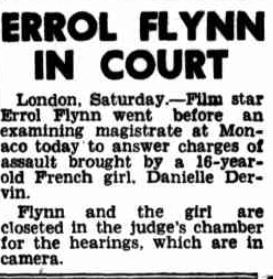
…
November 14, 1950
The Argus – Melbourne, Victoria
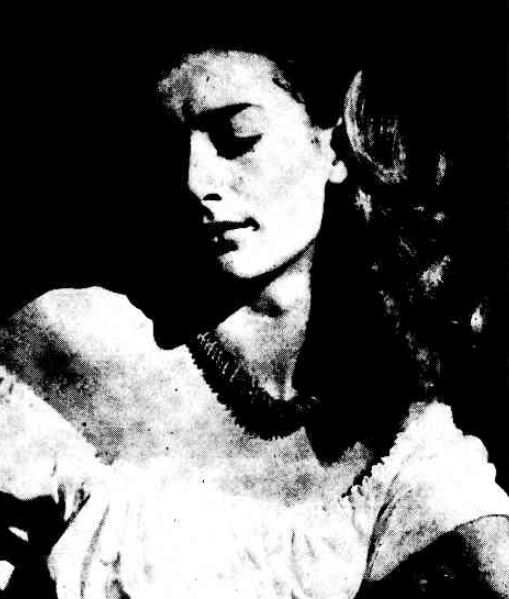

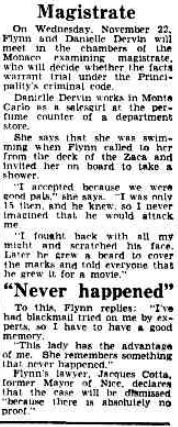
* Danielle Dervin may not have been her true name. Her true name may have been Danielle Duvivier.
— Tim
November 24, 1942
The Screen Theater Guild
Errol Flynn – Nan Grey – Alan Hale – Jane Wyman
…
…
…
— Tim
November 20, 1942
Minneapolis Star Journal
FBI Jails Boy in Extortion
13-Year-Old Asked $10,000 of Flynn
LOS ANGELES UPI
A $10,000 extortion plot against actor Errol Flynn was attributed to a 13-year-old San Bernardino schoolboy last night by the Federal Bureau of Investigation. The FBI said young Billy Seamster had sent a note to the actor, now awaiting trial on statutory charges, demanding the money on pain of death. The lad was arrested, said agent Richard B. Hood, in San Bernardino where he had directed the money to be sent. Hood said the note, received by Flynn Nov. 11 at his Beverly Hills home, read: “If you value your life and career, send a small package containing $10,000 in currency to the Otto Malt Shop. Your phone has been tapped. Don’t call police. You will be killed if you don’t comply.” It was signed “Jack Gilstrom.” The lad was released to his parents while the United States attorney’s office studies possible further action.
— Tim
November 22, 1946
At the Strand in Manhattan
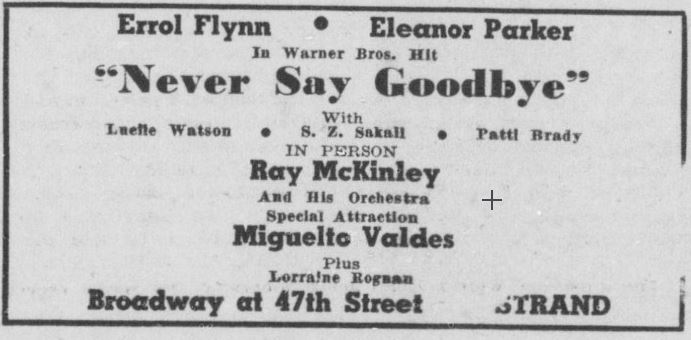
Jive Bomber
Led by Ray McKinley, famed drummer for Glenn Miller’s Army Air Force Band
…
…
Babalu by Señor Babalu
A Sensational Vocal and Dance Performance!
…
…
I Remember You
Lorraine and Ragnon
Lorraine’s husband and dance partner, Roy Ragnon, died in a plane crash during a WW II USO tour. Lorraine suffered very serious injuries from that same crash, and made an heroic comeback as a singer and comedienne, thus performing without her husband at the New York premier of Never Say Goodbye. This crash was depicted in the Susan Hayward film, With a Song in My Heart.
…
…
— Tim
November 21, 1941
New York Times
The Warners have been generous to a fault in paying their respects to General George Armstrong Custer. Certainly the man who is more famed for his celebrated last stand against the Sioux and allied tribes at Little Big Horn than for any of his several other exploits receives his due as a courageous soldier, and then some, in “They Died With Their Boots On,” which thundered into the Strand yesterday. Dismiss factual inaccuracies liberally sprinkled throughout the film’s more than two-hour length and you have an adventure tale of frontier days which for sheer scope, if not dramatic impact, it would be hard to equal.
Wave upon wave of cavalry charges packed with breath-taking thrills have been handled in masterly fashion by director Raoul Walsh, and they alone are worth the price of admission. Mr. Walsh, it is obvious, spared neither men, horses nor Errol Flynn’s General Custer in kicking up the dust of battle. But the director was not so fortunate in handling the personal drama and as a consequence “They Died With Their Boots On” has little verve between campaigns. With all the action of the Civil War sequences, it is not surprising that the intervening account of the General’s domestic life and his battle against political intrigue, which lacks genuine dramatic sustenance, should become a little wearying. After all, two hours and seventeen minutes requires a powerful lot of sustained drama. Mr. Walsh would have had a more compact and compelling entertainment had he whittled a half hour or so out of the script. But he more than makes up for this with his action shots.
From what the records show, “They Died With Their Boots On” is the screen’s first full-fledged attempt at spanning Custer’s remarkable career from his hazing as a West Point plebe, his almost story-bookish rise from second lieutenant of cavalry at the first Battle of Bull Run in 1861 to his appointment two years later as brigadier general of volunteers and commander of the Michigan brigade, which performed so brilliantly at Gettysburg. However fanciful the film’s account of his early Army career and the events in between his assignment as lieutenant colonel, Regular Army, of the Seventh Cavalry, may be, it nevertheless provides a broad view of a complex personality.
In the massacre at the Little Big Horn in 1876 the film credits Custer with knowingly sacrificing his small forces to prevent the warring Indians from swooping down upon General Terry’s unsuspecting regiment, a viewpoint in variance with certain historical accounts of the tragedy. Errol Flynn, who approximates the general in physical characteristics, is excellent as the dashing, adventuresome cavalryman. Olivia de Havilland is altogether captivating as his adoring wife. Others in the long cast who acquit themselves with credit are John Litel as General Phil Sheridan, Sidney Greenstreet as General Winfield Scott and Stanley Ridges as the fictitious Major Taipe who engineers Custer’s court-martial. George P. Huntley Jr. gives a magnificent performance as Custer’s fellow-officer and buddie.
THEY DIED WITH THEIR BOOTS ON; screen play by Wally Klein and Aeneas MacKenzie; directed by Raoul Walsh for Warner Brothers.George Armstrong Custer . . . . . Errol Flynn – Elizabeth Becon (Beth Custer) . . . . . Olivia deHavilland – Fitzhugh Lee . . . . . Regis Toomey- Major Romulus Taipe . . . . . Stanley Ridges – Ned Sharp . . . . . Arthur Kennedy – General Scott . . . . . Sidney Greenstreet – William Sharp . . . . . Walter Hampden – General Phil Sheridan . . . . . John Litel – Lieut. Butler . . . . . George P. Huntley Jr. – Crazy Horse . . . . . Anthony Quinn – California Joe . . . . . Charley Grapewin – Sergeant Doolittle . . . . . Joe Sawyer – Captain Webb . . . . . Frank Wilcox – Captain McCook . . . . . Selmer Jackson – Senator Smith . . . . . Minor Watson – Lieut. Frazier . . . . . DeWolf Hopper
A version of this article appears in print on Nov. 21, 1941 of the National edition with the headline: At the Strand.
…
…
…
— Tim
November 17, 1949
marble-arch.london/culture-blog/royal-film-performance-at-marble-arch-odeon/…
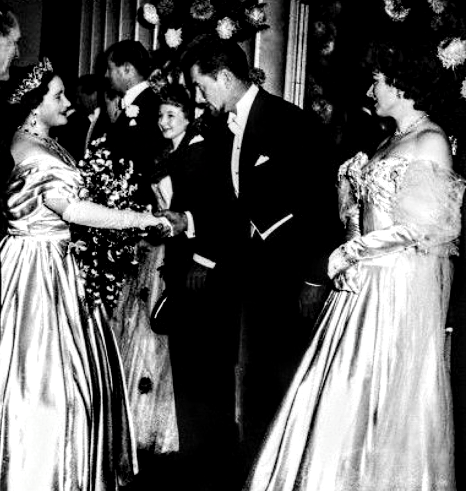
— Tim